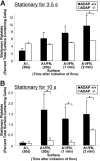ADAP is required for normal alphaIIbbeta3 activation by VWF/GP Ib-IX-V and other agonists
- PMID: 17003372
- PMCID: PMC1785130
- DOI: 10.1182/blood-2006-05-022301
ADAP is required for normal alphaIIbbeta3 activation by VWF/GP Ib-IX-V and other agonists
Abstract
Interaction between von Willebrand factor (VWF) and platelet GP Ib-IX-V is required for hemostasis, in part because intracellular signals from VWF/GP Ib-IX-V activate the ligand-binding function of integrin alphaIIbbeta3. Because they also induce tyrosine phosphorylation of the ADAP adapter, we investigated ADAP's role in GP Ib-IX-V signal transduction. Fibrinogen or ligand-mimetic POW-2 Fab binding to alphaIIbbeta3 was stimulated by adhesion of ADAP+/+ murine platelets to dimeric VWF A1A2 but was significantly reduced in ADAP-/- platelets (P<.01). alphaIIbbeta3 activation by ADP or a Par4 thrombin receptor agonist was also decreased in ADAP-/- platelets. ADAP stabilized the expression of another adapter, SKAP-HOM, via interaction with the latter's SH3 domain. However, no abnormalities in alphaIIbbeta3 activation were observed in SKAP-HOM-/- platelets, which express normal ADAP levels, further implicating ADAP as a modulator of alphaIIbbeta3 function. Under shear flow conditions over a combined surface of VWF A1A2 and fibronectin to test interactions involving GP Ib-IX-V and alphaIIbbeta3, respectively, ADAP-/- platelets displayed reduced alphaIIbbeta3-dependent stable adhesion. Furthermore, ADAP-/- mice demonstrated increased rebleeding from tail wounds. These studies establish ADAP as a component of inside-out signaling pathways that couple GP Ib-IX-V and other platelet agonist receptors to alphaIIbbeta3 activation.
Figures







Similar articles
-
Calpain regulation of cytoskeletal signaling complexes in von Willebrand factor-stimulated platelets. Distinct roles for glycoprotein Ib-V-IX and glycoprotein IIb-IIIa (integrin alphaIIbbeta3) in von Willebrand factor-induced signal transduction.J Biol Chem. 1997 Aug 29;272(35):21847-54. doi: 10.1074/jbc.272.35.21847. J Biol Chem. 1997. PMID: 9268316
-
Signaling through GP Ib-IX-V activates alpha IIb beta 3 independently of other receptors.Blood. 2004 May 1;103(9):3403-11. doi: 10.1182/blood-2003-10-3664. Epub 2004 Jan 15. Blood. 2004. PMID: 14726383
-
Glycoprotein Ib-IX-mediated activation of integrin alpha(IIb)beta(3): effects of receptor clustering and von Willebrand factor adhesion.J Thromb Haemost. 2003 Jun;1(6):1150-7. doi: 10.1046/j.1538-7836.2003.00295.x. J Thromb Haemost. 2003. PMID: 12871313
-
Platelet physiology and thrombosis.Thromb Res. 2004;114(5-6):447-53. doi: 10.1016/j.thromres.2004.07.020. Thromb Res. 2004. PMID: 15507277 Review.
-
Platelet adhesion receptors and (patho)physiological thrombus formation.Histol Histopathol. 2001 Jul;16(3):969-80. doi: 10.14670/HH-16.969. Histol Histopathol. 2001. PMID: 11510988 Review.
Cited by
-
Phosphorylation of Kindlins and the Control of Integrin Function.Cells. 2021 Apr 7;10(4):825. doi: 10.3390/cells10040825. Cells. 2021. PMID: 33916922 Free PMC article. Review.
-
Crucial role of SLP-76 and ADAP for neutrophil recruitment in mouse kidney ischemia-reperfusion injury.J Exp Med. 2012 Feb 13;209(2):407-21. doi: 10.1084/jem.20111493. Epub 2012 Jan 30. J Exp Med. 2012. PMID: 22291096 Free PMC article.
-
The Multiple Roles of the Cytosolic Adapter Proteins ADAP, SKAP1 and SKAP2 for TCR/CD3 -Mediated Signaling Events.Front Immunol. 2021 Jul 6;12:703534. doi: 10.3389/fimmu.2021.703534. eCollection 2021. Front Immunol. 2021. PMID: 34295339 Free PMC article. Review.
-
Characterization of Mice with a Platelet-Specific Deletion of the Adapter Molecule ADAP.Mol Cell Biol. 2019 Apr 16;39(9):e00365-18. doi: 10.1128/MCB.00365-18. Print 2019 May 1. Mol Cell Biol. 2019. PMID: 30833485 Free PMC article.
-
Macrophages require Skap2 and Sirpα for integrin-stimulated cytoskeletal rearrangement.J Cell Sci. 2012 Nov 15;125(Pt 22):5535-45. doi: 10.1242/jcs.111260. Epub 2012 Sep 12. J Cell Sci. 2012. PMID: 22976304 Free PMC article.
References
-
- Savage B, Saldivar E, Ruggeri ZM. Initiation of platelet adhesion by arrest onto fibrinogen or translocation on von Willebrand factor. Cell. 1996;84:289–297. - PubMed
-
- Savage B, Almus-Jacobs F, Ruggeri ZM. Specific synergy of multiple substrate-receptor interactions in platelet thrombus formation under flow. Cell. 1998;94:657–666. - PubMed
-
- Sakariassen KS, Bolhuis PA, Sixma JJ. Human blood platelet adhesion to artery subendothelium is mediated by factor VIII-Von Willebrand factor bound to the subendothelium. Nature. 1979;279:636–638. - PubMed
Publication types
MeSH terms
Substances
Grants and funding
LinkOut - more resources
Full Text Sources
Molecular Biology Databases
Miscellaneous

